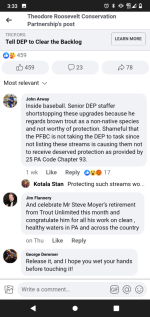The Upper Kettle Creek Basin was in the Wild Brook Trout Enhancement program which ended in 2015 because it didn't achieve the desired results which was an increase of adult (>4 inches) or legal size (>7 inches) wild brook trout.
However according to the minutes from the 117th Meeting of the PFBC held in 2016:
During the review of the Wild Brook Trout Enhancement Program, staff noted that the
upper Kettle Creek basin streams seemed to respond differently than the other streams
included in the study. Staff worked with the Pennsylvania Cooperative Fish and Wildlife
Research Unit to analyze the data on an individual stream basis to determine if this was
the case. Results indicated that five of the seven sample sites located on upper Kettle
Creek and four of its tributaries had a significant increase in the number of legal-size
Brook Trout. These were the only streams managed under the wild Brook Trout
enhancement regulations that showed a significant increase. The upper Kettle Creek
watershed is the largest stronghold for Brook Trout in Pennsylvania, is a destination
fishery for anglers, and was the largest system included in the study. These factors may
help to explain why this system responded differently than the other waters in the
program.
Based on the final data review and the ecological importance of the upper Kettle Creek
watershed, staff recommend that the upper Kettle Creek basin from the headwaters of
Kettle Creek downstream to the confluence with Long Run, including Long Run and all
tributaries upstream to the headwaters, be designated as catch and release all-tackle under
58 Pa. Code § 65.15
Currently the Upper Kettle Creek Basin is under the Catch & Release All Tackle designation which only differs from the former Wild Brook Trout Enhancement program in offering the ability to harvest five NON-wild brook trout per day.
I have no facts on the matter but I doubt there was ever significant brown numbers or a significant harvest of legal sized brown trout there to have effected the different results achieved at Kettle during the Wild Brook Trout Enhancement program.
A comparison to the 2016 results would be a good first step...







